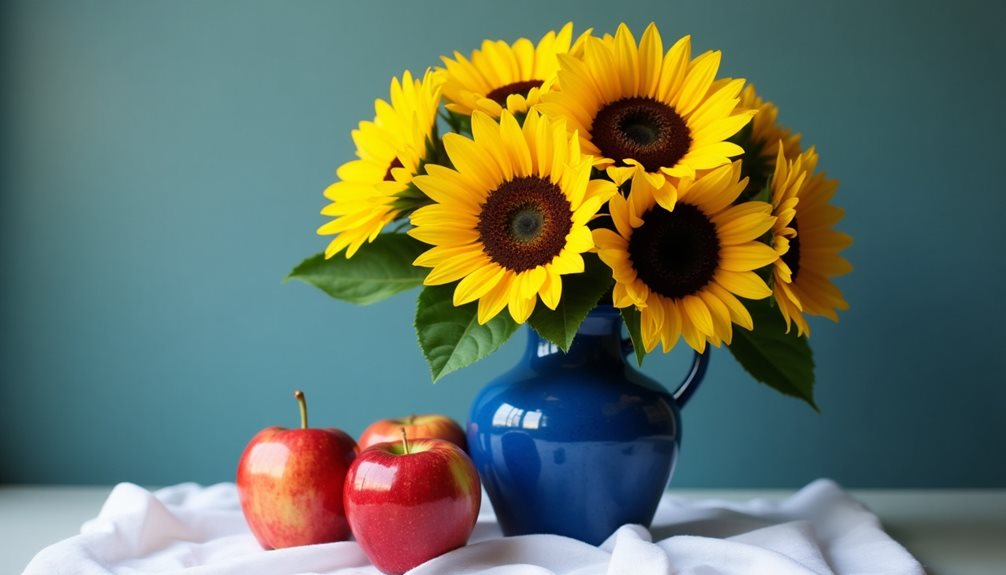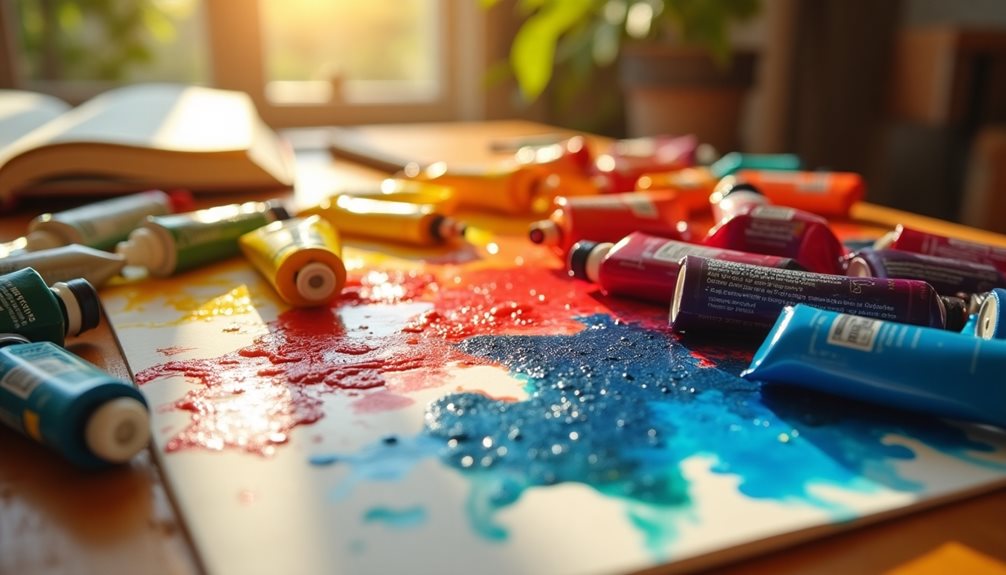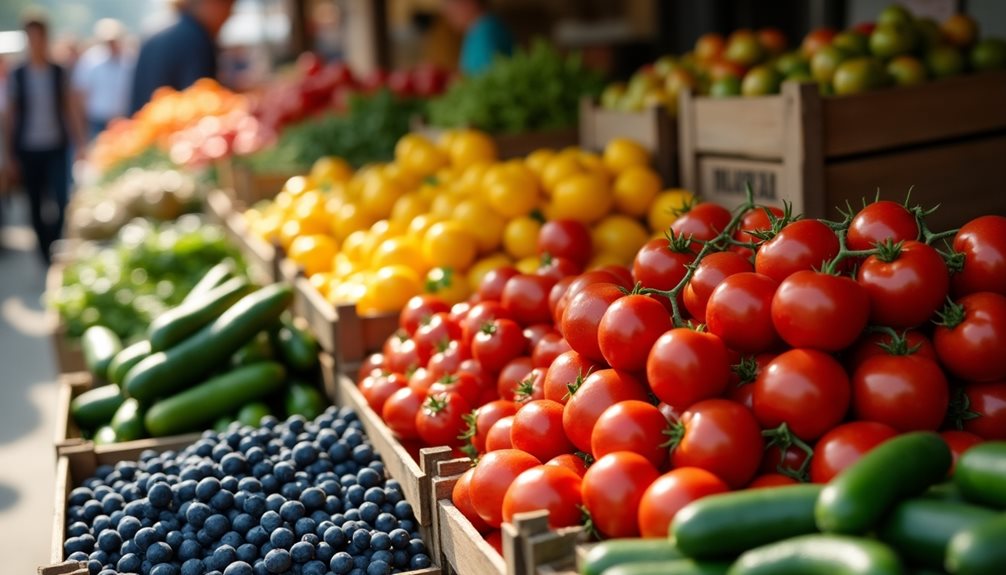Table of Contents
ToggleBasic Colors in Russian

Colors in Russian culture are far more than mere visual descriptors; they are deeply intertwined with history, tradition, and social meaning. The Russian language features a core set of color terms that are immediately familiar—красный (red), синий (blue), зелёный (green), жёлтый (yellow), белый (white), чёрный (black), коричневый (brown), оранжевый (orange), розовый (pink), фиолетовый (purple), and серый (gray). Each of these colors not only describes the world but also carries a web of associations that reveal much about Russian society and its past.
The word for red, красный, holds a special place in Russian. Its root is shared with “beautiful” (красивый), reflecting the high regard for the color in Russian history and art. Red has long symbolized not just physical beauty but also celebration and importance—think of the famous Красная Площадь (Red Square) in Moscow, which originally meant “Beautiful Square.” In the 20th century, red took on powerful political connotations as the emblematic color of the Soviet Union, representing revolution and the struggle for a new social order.
Blue in Russian is fascinating because there are actually two basic terms: синий for dark or true blue, and голубой for light blue. This distinction, which is absent in many other languages including English, highlights how closely Russians observe the world around them. Blue is often connected with honesty, calmness, and eternity, perhaps inspired by the endless Russian skies and vast lakes. Light blue carries special associations with purity and childhood, making it a color of innocence and gentle emotion.
Green, or зелёный, draws its meaning from nature and growth. The etymology traces back to the verb “to grow” (зеленеть), emphasizing green’s role as a symbol of life, renewal, and springtime. In Russian folklore and fairy tales, green is frequently linked to youth, vitality, and the natural world awakening after winter.
Yellow is a color of contrasts in Russian tradition. On one hand, жёлтый suggests warmth, sunlight, and happiness; on the other hand, it sometimes implies caution or even deceit. The term “жёлтая пресса” refers to tabloid journalism—publications that are sensationalist or unreliable—which hints at yellow’s less positive associations.
White, or белый, is almost universally positive in Russian culture. It symbolizes purity, innocence, and new beginnings. This is reflected in wedding traditions and widespread idioms. The dominance of white during the long Russian winter may have reinforced its status as a symbol of peace and hope.
Black (чёрный) carries more somber associations. It often stands for mystery, the unknown, or mourning—common themes in Russian literature and folklore. Black is also found in many idiomatic expressions where it represents hardship or sorrow.
Brown (коричневый) is less culturally loaded but is often associated with reliability and earthiness. Its presence in everyday language is practical rather than symbolic.
Orange (оранжевый) is a relatively modern addition to the Russian palette. The term entered common use only in the 20th century, coinciding with advances in scientific understanding of color. Today, orange represents energy, vibrancy, and sometimes innovation.
Pink (розовый) is connected to youthfulness and affection. It derives from “роза” (rose) and often signals romance or gentle feelings. Purple (фиолетовый), meanwhile, evokes mystery and creativity—a color sometimes linked to spirituality or magic.
Gray (серый) usually represents neutrality or modesty. While it can also imply dullness or ambiguity, gray has its own understated significance in a culture that appreciates subtlety.
The Russian language’s approach to color reveals a complex interplay between perception, environment, and cultural history. Even everyday expressions are colored by these associations; language becomes a window into how Russians see and interpret their world. Whether through ancient roots or modern coinages, basic color terms in Russian continue to reflect a rich tapestry of emotion, belief, and identity.
Describing Shades and Tones
Describing shades and tones in Russian adds depth and precision to both everyday conversation and artistic description. Russian, like many languages, uses a rich set of terms to capture subtle variations in color, which can carry not only visual but also emotional significance.
For example, the color синий (blue) is foundational, but speakers rarely stop there. They use светло-синий (light blue) for gentler, airy hues reminiscent of spring skies, and тёмно-синий (dark blue) for deeper, more intense shades often associated with the evening sky or deep water. These distinctions are not just visual—they can suggest mood, with light blue evoking tranquility (спокойствие) and dark blue implying seriousness or depth (глубина).
Green also presents a wide spectrum in Russian. The word зелёный (green) is basic, but to capture the vibrancy of new leaves or grass, one might say ярко-зелёный (bright green). For more subdued, earthy tones seen in olives or military uniforms, Russians use оливковый (olive green) or защитный (khaki/olive drab). Each shade can influence the imagery and emotion of a description—ярко-зелёный is lively and fresh, while оливковый feels mature and natural.
Some of the most expressive Russian color words describe specific or nuanced shades:
- небесно-голубой (sky blue): a soft, clear blue that brings to mind open skies and freedom.
- бирюзовый (turquoise): a blend of blue and green, often used to describe water in tropical locations.
- лазурный (azure): a bright, vivid blue, frequently used in poetry and literature for its intense beauty.
- мятный (mint green): a gentle, cool green with a hint of freshness, often associated with calmness and relaxation.
- изумрудный (emerald): a deep, jewel-like green used for lush forests or gemstones.
| English | Russian (Cyrillic + Phonetic) | Meaning |
|---|---|---|
| Light blue | светло-синий (svyet-lo see-nee) | A gentle, airy shade of blue, reminiscent of spring skies |
| Dark blue | тёмно-синий (tyom-no see-nee) | A deep, intense shade of blue, often linked to evening sky or deep water |
| Tranquility | спокойствие (spa-koyst-vee-ye) | A feeling of calmness and peace, often evoked by light colors |
| Depth | глубина (gloo-bee-na) | Seriousness or profundity, often implied by darker colors |
| Bright green | ярко-зелёный (yar-ko zye-lyo-ny) | A vivid, fresh green, like new leaves or grass |
| Olive green | оливковый (a-leev-ko-viy) | A subdued, earthy green seen in olives or military uniforms |
| Khaki/olive drab | защитный (za-sheet-nyi) | A muted, protective green shade, commonly used in military contexts |
| Sky blue | небесно-голубой (nye-byes-no go-loo-boy) | Soft, clear blue, evoking open skies and freedom |
| Turquoise | бирюзовый (bee-ryu-zo-viy) | A blue-green blend, often describing tropical water |
| Azure | лазурный (la-zoor-niy) | A bright, vivid blue, often used in poetry for its beauty |
| Mint green | мятный (myat-niy) | Gentle, cool green with a fresh feeling |
| Emerald | изумрудный (ee-zoo-mrood-niy) | Deep, jewel-like green associated with lush forests or precious stones |
| Light (modifier) | светло- (svyet-lo-) | Prefix meaning “light,” used to describe paler shades |
| Dark (modifier) | тёмно- (tyom-no-) | Prefix meaning “dark,” used to describe deeper shades |
| Pale (modifier) | бледно- (blyed-no-) | Prefix meaning “pale,” used for less saturated colors |
| Bright (modifier) | ярко- (yar-ko-) | Prefix meaning “bright,” used for more vivid or intense colors |
The Russian language also uses intensifiers and modifiers for further precision. Prefixes like светло- (light), тёмно- (dark), бледно- (pale), and ярко- (bright) are added to basic color words: светло-зелёный (light green), тёмно-красный (dark red), бледно-розовый (pale pink), ярко-жёлтый (bright yellow).
These linguistic nuances allow Russian speakers to share not just what they see, but also how they feel about what they see. Whether describing the shifting colors of a sunset or the subtle green of springtime buds, these words enrich communication and deepen the connection between language and perception.
Common Phrases for Color Descriptions
Color descriptions in Russian use a wide range of vivid phrases and idioms that go beyond simple labels. These expressions often draw on familiar, everyday objects or aspects of nature. They help speakers convey not only the basic shade, but also emotional or cultural undertones that are significant in Russian society.
For example, Russians often use comparisons to describe the intensity or shade of a color. The phrase “красный как кровь” (krasnyy kak krov’—red as blood) doesn’t just indicate a deep red; it brings up feelings of vitality, danger, or intensity. Красный (krasnyy) means “red,” and кровь (krov’) means “blood.” This phrase has strong historical and cultural weight, as red is often associated with revolution, power, and important holidays in Russia.
Another common phrase is “зелёный как трава” (zelyonyy kak trava—green as grass). Here, зелёный (zelyonyy) means “green,” and трава (trava) means “grass.” This comparison suggests freshness, youth, and the renewal of springtime. In Russian culture, green is linked to health, new beginnings, and sometimes even naivety.
Russians also use color phrases to compare shades with familiar foods or objects:
- “Чёрный как уголь” (chyornyy kak ugol’—black as coal).
- Чёрный (chyornyy) = black; уголь (ugol’) = coal. This phrase emphasizes total darkness or something very intense.
- “Белый как снег” (belyy kak sneg—white as snow).
- Белый (belyy) = white; снег (sneg) = snow. Snow is a central image in Russia, so this comparison highlights something pure, clean, or flawless.
- “Жёлтый как лимон” (zholtyy kak limon—yellow as lemon).
- Жёлтый (zholtyy) = yellow; лимон (limon) = lemon. This phrase is often used to describe a bright, cheerful yellow.
Color words themselves often have cultural meanings. For instance:
- Голубой (goluboy) means “sky blue” and is associated with calmness and peacefulness.
- Серый (seryy) means “gray,” which can symbolize dullness or routine.
Russians also use colors in idioms to express emotions or situations. For example:
- “Чёрная зависть” (chyornaya zavist’) means “black envy,” describing strong jealousy.
- “Белая зависть” (belaya zavist’) means “white envy,” describing a harmless or friendly kind of envy.
- “Синий от холода” (siniy ot kholoda—blue from cold) describes someone who is freezing.
These rich phrases show how deeply colors are woven into Russian language and worldview. Learning them helps English speakers understand not just what Russian speakers see, but how they feel and think about the world around them.
Colors in Nature and Their Significance
Nature in Russia is painted with many vivid colors, each carrying special meaning and cultural weight. These colors do not just make the landscape beautiful—they also shape the way people think, feel, and express themselves. In Russian culture, the natural world and its colors often appear in literature, art, and daily language, serving as powerful symbols.
Green (Зелёный — [zye-LYOH-nyj])
Meaning: Fertility, Renewal, Life
Green is deeply associated with the growth and richness of the Russian countryside. The endless forests, rolling fields, and springtime meadows make green a symbol of new beginnings, health, and hope. In Russian folk songs and stories, green often stands for youth and the promise of the future. It is also tied to the idea of family and fertility—lush green fields mean good harvests and healthy families.
Blue (Синий — [SEE-nee])
Meaning: Tranquility, Spirituality, Loyalty
Blue is strongly connected to the open Russian sky and the many rivers and lakes stretching across the country. This color brings thoughts of calmness, peace, and spiritual reflection. Blue is also linked to honesty and trustworthiness; in old Russian sayings, someone with “clear blue eyes” (чистые синие глаза) is seen as sincere and kind. The blue domes of Orthodox churches are meant to remind people of heaven and inspire spiritual thoughts.
Red (Красный — [KRAHS-nee])
Meaning: Passion, Beauty, Power
Red is perhaps the most famous color in Russian symbolism. It shows up in nature as wild berries, autumn leaves, and blooming poppies. Red stands for energy, love, strength, and beauty. In Russian, the word for “red” (красный) shares its root with the word for “beautiful” (красивый — [kra-SEE-vyj]), showing how closely these ideas are linked in the culture. Historically, red has also symbolized power and importance—Red Square in Moscow is not named for its color, but for its beauty and significance.
Cultural Connections
Colors from nature are woven into traditional clothing (like the bright embroidery on folk costumes), holiday decorations, and even language. Russian proverbs and poems often use these colors to express feelings or describe characters. For example:
- “Зелёная весна” (Green spring) means a fresh start.
- “Синее небо” (Blue sky) symbolizes peace.
- “Красная девица” (Red/beautiful maiden) refers to a beautiful girl.
Understanding how Russians view these colors helps explain their connection to both the natural world and cultural identity. The meanings go beyond simple decoration—they represent values that are part of everyday life.
Using Colors in Everyday Situations
In various everyday situations, individuals often rely on color to communicate emotions and influence perceptions. Color symbolism plays a crucial role in shaping interactions, as different hues evoke distinct feelings and responses.
For instance, red may signify passion or urgency, while blue often conveys calmness and trust. These associations are deeply intertwined with cultural perceptions; for example, white is associated with purity in Western cultures but can symbolize mourning in some Eastern traditions.
Consequently, awareness of these nuances is important for effective communication. Utilizing colors thoughtfully can enhance dialogue and foster deeper connections.
Colors are a big part of everyday life. They are used not just to describe objects, but also to show feelings, attitudes, and even to give certain messages without using words. In Russian, just like in English, colors have both literal and symbolic meanings. Understanding these can help you communicate more clearly and understand Russian culture better.
Color Symbolism in Russian Culture
Just as in English, colors in Russian can be used to express emotions or ideas. For example:
- Red can mean love, beauty, or warning.
- Blue can mean peace, loyalty, or sadness.
- White can mean purity, innocence, or sometimes mourning (especially in some Eastern European traditions).
- Black can mean darkness, evil, or elegance.
- Green can mean youth, freshness, or sometimes jealousy.
Knowing how colors are used in Russian daily life and language helps avoid misunderstandings and makes your speech richer.
Example Situations
- Giving flowers: In Russia, the color of flowers is very important. Red roses are for love. White flowers are for weddings or funerals.
- Clothing: Wearing black to a party may be seen as serious or elegant. Bright colors may be seen as cheerful.
- Interior design: Blue walls may make a room feel calm. Red objects might be used to attract attention.
Notes on Usage
- In Russian, adjectives (including colors) must agree in gender, number, and case with the nouns they describe.
- Example: красная роза (kras-na-ya ro-za) – “red rose” (feminine)
- красный цветок (kras-nee tsve-tok) – “red flower” (masculine)
- Russian also uses color expressions to describe people’s moods or situations:
- чёрная полоса (chyor-na-ya pa-la-sa) – “a streak of bad luck” (literally: black stripe)
- белая зависть (bye-la-ya za-veest’) – “white envy” (meaning mild or harmless envy)
Understanding and using color words in Russian will make your communication more natural and help you connect better with native speakers.
Tips for Expanding Your Color Vocabulary

Expanding your color vocabulary is more than just learning the names of basic colors like red, blue, or green. It involves recognizing and describing the full range of shades, tints, and tones that exist in the world around us. This skill can make your speech and writing more vivid and precise.
![]()
1. Study Color Symbolism Across Cultures
Colors have unique meanings in different cultures. For example, in Western cultures, white (белый — [BYE-lee]) is often linked to purity and weddings, while in many Asian cultures, white can symbolize mourning. Red (красный — [KRAS-nee]) often stands for love or danger in English-speaking countries, but in Russia, it can also represent beauty and importance (“красная площадь” — Red Square, literally “Beautiful Square”). Learning about these associations can help you understand why people react to certain colors in specific ways.
2. Use More Precise Words for Colors
Instead of saying “blue,” try using more specific words, such as:
- Navy (тёмно-синий — [TYOM-nuh SEE-nee]): a very dark blue
- Turquoise (бирюзовый — [bee-roo-ZO-viy]): a blue-green shade
- Sky blue (небесно-голубой — [nye-BYES-nuh guh-loo-BOY]): a light blue, like the sky
For “green,” you could use:
- Emerald (изумрудный — [ee-zoo-MROOD-niy]): a rich, bright green
- Olive (оливковый — [a-LEEV-kuh-viy]): a yellowish-green
Learning these descriptive terms will help you create clearer images for your listener or reader.
3. Engage in Creative Activities
Participating in activities like painting (рисование — [ree-so-VAH-nee-ye]), photography (фотография — [fa-ta-GRAH-fee-ya]), or fashion design (моделирование одежды — [ma-de-lee-RO-va-nye a-DEZH-dy]) exposes you to a wider palette of colors. When you mix paints, you see firsthand how combining yellow and blue creates different shades of green. When editing photos, adjusting brightness and saturation helps you notice colors you might otherwise overlook.
4. Learn Color Words in Other Languages
Russian, for example, has many colorful expressions and more color words beyond the basics. Here are a few useful ones:
- Розовый ([ROH-zuh-viy]): Pink
- Серый ([SYEH-riy]): Gray
- Фиолетовый ([fee-a-LYE-ta-viy]): Purple/Violet
- Бежевый ([BYE-zhi-viy]): Beige
- Коричневый ([ka-REECH-ne-viy]): Brown
By learning color words in another language, you also become more aware of subtle differences and variations.
Key Russian Phrases for Talking About Color:
- Какого цвета? ([ka-KO-va TSVYE-ta?]) — What color is it?
- Это светло-зелёный ([E-ta SVET-la ze-LYO-nee]) — This is light green.
- Мне нравится этот оттенок синего ([Mnye NRAV-i-tsa E-tat at-TYE-nak SEE-ne-va]) — I like this shade of blue.
Expanding your color vocabulary isn’t just about memorizing new words; it’s about learning to notice the world’s details and expressing them clearly. The journey to mastering color descriptions will enrich both your language skills and your appreciation for the world around you.
Frequently Asked Questions
How Do Russians Perceive Colors Differently Than Other Cultures?
Russians often associate colors with specific cultural significance and symbolism, which can differ markedly from other cultures. For instance, red symbolizes beauty and celebration, while white represents purity, showcasing diverse interpretations of color across societies.
Are There Regional Variations in Color Vocabulary in Russia?
Regional variations in color vocabulary across Russia reflect diverse regional dialects and cultural influences. These differences illustrate how local traditions and environmental factors shape color perception, enriching the linguistic landscape and enhancing individual expression within communities.
What Are Some Idiomatic Expressions Involving Colors in Russian?
Exploring color idioms reveals their cultural significance in Russian society. Expressions like “red tape” or “green with envy” illustrate emotions and social commentary, demonstrating how colors enrich language and reflect cultural values and experiences.
How Can Learning Colors Enhance My Russian Language Skills?
Learning colors enhances Russian language skills by deepening understanding of color associations and their cultural significance. This knowledge fosters richer conversations, enabling learners to connect more meaningfully with native speakers and appreciate the nuances of the language.



